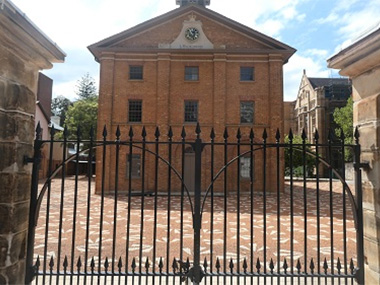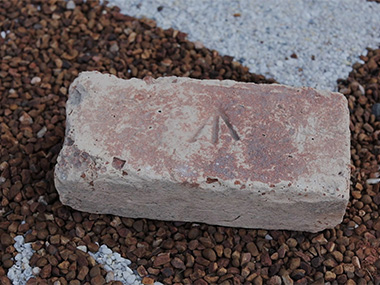The Ephemeral and the Ineradicable

Wiradjuri artist Jonathan Jones surrounded by his emu footprints/convict arrows in the Hyde Park Barracks courtyard
Posted by Jeremy Eccles | 02.03.20
Gallery: Sydney Living Museums
Dates:
20.02.20
: 15.03.20
Location: Macquarie Street, Sydney
The recent reopening of the Hyde Park Barracks in central Sydney was greeted as a great Indigenous event for the 2500 square metre courtyard was transformed (briefly) by Wiradjuri artist Jonathan Jones into a First Nations statement. Some optimist even labelled the event, "'The Wrapped Coast' for this generation” - referencing Christo and Jeanne Claude's mighty coating of the cliffs at Little Bay 50 years ago.
But the detailed patterning of tripartite marks that reference both the Aboriginal emu and the convict arrow of the British Empire will all-too-soon disappear from both the ground and, I suspect, the memory. For, like sand paintings in the Deserts, they will be ceremonially danced into red and white dust by NAISDA students on Sunday 15th March. But then, what will be left will be the radical transformation of the Barracks themselves. And this has been little noted.
For the Barracks are part of a collection of convict buildings and sites that have World Heritage status only because of that historic association. But time, wake(ful)ness and historical learning have caught up with this monodimensional view of Australia's earliest days. Books such Stephen Gapps's important 'The Sydney Wars' have forced us to realise that the Eora Nation and its neighbours didn't simply disappear into the night through sickness and military weakness as the British colonial incursion spread out beyond Sydney Cove, but they fought back fiercely until Governor Macquarie (commissioner of the Barracks) brought overwhelming military force to bear against them.
And this is now represented in the Barracks displays which used to be all about the convicts.Two rooms, maybe a quarter of the whole now tell the stories of inter-racial clashes in which the convicts were often the shock troops sent out beyond the areas of greater military protection.
Using sound systems that employ geolocational techniques borrowed from MONA in Hobart, you move from tough convict stories from crime to rehabilitation, to the Myall Creek Massacre, which happened nowhere near Sydney. You also move from 'FEAR' to 'HOPE' and the jolly reassurance that “Sydney is getting fat and pleased with itself”! Has anything changed?? Well, perhaps hearing a Liberal government Minister in Don Harwin – who covers both Arts and Aboriginal Affairs portfolios – declare that “This was, is and always will be Gadigal land” despite the appearance of a 200 year old building on it, and then find proof of this new acceptance inside the building.
Artist Jonathon Jones himself admits that “sites like this are complex, for the Barracks were designed to erase Aboriginal history”. So he hoped that his “shared symbology” of the convict arrow and the Indigenous emu who lives in the night sky where we see the Southern Cross and is a powerful figure of paternity as the males rear emu chicks, will “wake up shared relationships”.
In the brief period of the symbology's clear existence there are almost daily talks about aspects of this arousal, though, as far as I can see, the convict side doesn't get a look in. First Nations Professors Larissa Behrendt and Megan Davis appear on the next two Wednesday evenings and there's weekend storytelling and performance. It all works up to NAISDA leading a mass workshop and the public performance of a contemporary emu dance at 2pm on Sunday 15th March causing the final destruction of 'untitled (maraong manaóuwi)' by mixing the stones inextricably.
URL: https://sydneylivingmuseums.com.au/exhibitions/untitled-maraong-manaouwi
Share this:
»  del.icio.us
»
del.icio.us
»  Digg it
»
Digg it
»  reddit
»
reddit
»  Google
»
Google
»  StumbleUpon
»
StumbleUpon
»  Technorati
»
Technorati
»  Facebook
Facebook
Contact Details
Gallery: Sydney Living Museums
Email: info@slm.com.au
Telephone: +61 2 8239 2211
Address: Head Office: The Mint, 10 Macquarie Street Sydney 2000 NSW

The majestic Barracks with their conflicted history

A convict brick with its characteristic claim to be the property of the British Empire
Where is the exhibition?
Further Research
Gallery: Sydney Living Museums
Artists: Jonathan Jones
News Tags: Don Harwin | Hyde Park Barracks | Jeremy Eccles | Larissa Behrendt | Megan Davies | Sydney Living Museums | The Mint
News Categories: Australia | Blog | Event | Exhibition | News | Other Event
Exhibition Archive
- 03.03.20 | EMILY v CLIFFORD
- 02.03.20 | The Ephemeral and the Ineradicable
- 25.02.20 | WADJUK IN THE BLACK
- 17.12.19 | Sotheby's NY Inaugural Aboriginal Art Auction
- 11.12.19 | Festivals in the Blak
- 11.12.19 | Cairns Airport Commission
- 09.12.19 | KNOWLEDGE GROUND
- 30.11.19 | Linear?
- 28.11.19 | The Auction Time of Year
- 25.10.19 | It's Time for Tarnanthi
- 02.10.19 | FIBRE ALCHEMY
- 17.09.19 | Fondation Opale Glows Opalescent
- 13.09.19 | 'Mapa Wiya' (Your Map’s Not Needed)
- 08.09.19 | Sydney Goes Contemporary
- 04.09.19 | Victorian Bonanza!
Advertising

